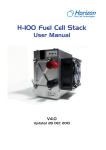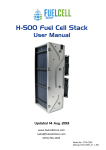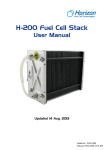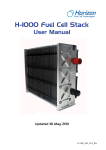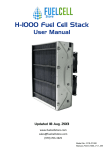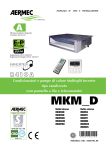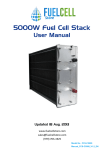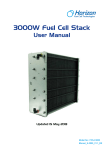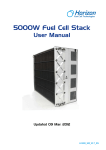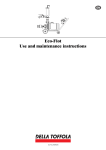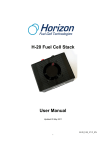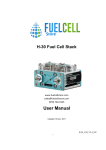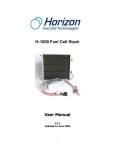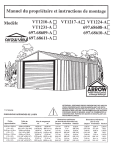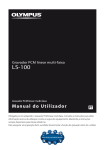Download H-1000 User Manual
Transcript
Disclaimer H-1000 Fuel Cell Stack User Manual This manual incorporates safety guidelines and recommendations. However, it is not intended to cover all situations. It is the responsibility of the customer to meet all local safety requirements and to ensure safety during operation, maintenance and storage of the H-1000 stack. Although all efforts have been made to ensure the accuracy and completeness of the information contained in this document, Horizon reserves the right to change the information at any time and assumes no liability for its accuracy. Actions that will void the fuel cell and controller warranty: ● ● ● ● ● ● ● Attempt,underanycircumstance,todisassembleorinappropriatelytamperwith the fuel cell. OperatethefuelcellwithacontrollernotdesignedandbuiltbyHorizonforthe specificfuelcell. Operatethefuelcellwithvalvesandblowers,thatarenotprovidedbyHorizonfor thespecifiedfuelcellandcontroller. Disassemblethefuelcell. Disassemblethecontroller. Operatingthefuelcellandcontrollerthatisnotinthesetupand/orspecifiedinthe usermanualprovideforthespecificproduct. OperatethefuelcellstackwithoutthecontrollerproducedbyHorizonorwiththe controller not produced by Horizon. Do not attempt, under any circumstance, to disassemble or inappropriately tamper with the fuel cell. There will be no repair, replace or refund should disassembly or tampering occur. If you have questions or need help with regards to the fuel cell and its technology please contact: [email protected] IMPORTANT In order for the warranty to come into effect the stack must be registered on the Horizon Warranty Page at: www.horizonfuelcell.com/warranty.htm Updated 09 Oct. 2012 2 3 Table of Contents 1. Safety 1. Safety.............................................................................................. 1 2. Terminology....................................................................................... 6 3. Stack and System Component Information...................................... 10 4.TechnicalSpecifications................................................................... 12 5. System Set Up.................................................................................. 13 6. Notes for the set up .......................................................................... 20 7.SystemSetupDiagram.................................................................... 22 8.OperatingProcedure........................................................................ 23 9. Polarization Curves........................................................................... 26 Please read all instructions carefully prior to product use and keep this manual for future reference. The safety guidelines included here may not cover every situation. Use common sense. 1.1 General information For this unit to generate electrical power, a supply of hydrogen fuel is necessary. It is important for any operator to be aware of, understand, and follow all local safety requirements related to the handling of hydrogen and compressed gases. Ensure that your facility conforms to all local regulatory requirements, including building codes and recommendations. The fuel cell system has built-in safeguards and is designed to shut down automatically if any outof-range operating condition occurs. Possible situations include low cell voltage, high current, high temperature, low fuel pressure. •Donotoperatethestackonagradeofmorethan65℃. •Donotconnectordisconnectpowercableswhenthefuelcellstackisenergised. •Donotdismantlethesystem.ContactHorizonifyouhaveanyconcernsaboutoperation. 1.2 Using Hydrogen WARNING!FIREOREXPLOSION 10. Storage and Re-use.......................................................................... 27 Keep all sources of ignition away from hydrogen. 11. Troubleshooting&System Checks...................................................... 28 Thisunituseshydrogenfuel.Hydrogenisacolourless,odourlessandflammablesubstance.Itis highlycombustibleinthepresenceofoxygenandburnswithacolourlessflame. 12.FuelCellDrawing.............................................................................. 32 13. FAQ................................................................................................... 33 Leakinggasmaybehotandposeaburndanger.Stoptheflowofgas–ifyouarenotindanger– andusewatertocoolthearea.Iffireoccurs,donotattempttoextinguishflames,allowthefireto burn out. Prevent overexposure to hydrogen. Hydrogen is non-toxic but can act as a simple asphyxiant by displacing the oxygen in the air. There are no warnings before unconsciousness results. When operating the stack in an enclosure: •Ensureventilationslotsareclearandunobstructedatalltimesduringoperation. •Operatewithinthetemperatureslimitsstatedinthemanual. •Neveroperateifanalarmconditionexists. Note: We highly recommend customer use a hydrogen sensor(not provided) to detect the hydrogen leakage. 4 5 1.3 Handling Compressed Gas Cylinders 1.5 Flammability and volatility WARNING Donothandlecompressedhydrogengascylinderswithouttrainingorexperience. Hydrogen is flammable over concentrations of 4 – 75% by volume in air, and is explosive over concentrationsof15–59%.Asaresult,evensmallleaksofhydrogenhavethepotentialtoburnor explode.Leakedhydrogencanconcentrateinanenclosedenvironment,therebyincreasingtheriskof combustion and explosion. •Useapressureregulatortocontrolthefuelinletpressuretothesystem. •Donotalterthefittingonaregulator.Askexperiencedpersonnelforhelp. •Donotattempttoforcegascylinderthreads. •Nevertransportagascylinderwithregulatorsattached.Ensurecylindercapsareinplace.Always use a cylinder cart with a safety strap or chain. •Secureahigh-pressurecylindertoabench,post,orfixedobjecttoavoidaccidentalcontact. •AvoidunnecessarycontactwithOn/Offvalves.Theycaneasilymoveto“On”byaccident. 1.4HydrogenLeakage Hydrogen is colourless, odourless and tasteless. Hydrogen is non-toxic but can act as a simple asphyxiant by displacing the oxygen in the air. There are no warning symptoms before unconsciousness results. WARNING Inhaling hydrogen can lead to unconsciousness and asphyxiation. Hydrogen molecules are smaller thananyothergas,makinghydrogenmoredifficulttocontain.Itcandiffusethroughmanymaterials consideredairtight.Fuellines,non-weldedconnections,andnon-metalsealssuchasgaskets,O-rings, pipe thread compounds and packings present potential leakage or permeation sites. Furthermore, hydrogen’s small molecule size results in high buoyancy and diffusivity, so leaked hydrogen will rise and become diluted quickly. Constant exposure to hydrogen causes hydrogen embrittlement in many materials. The mechanisms thatcausehydrogenembrittlementeffectsarenotwelldefined.Factorsknowntoinfluencetherateand severity of hydrogen embrittlement include hydrogen concentration, hydrogen pressure, temperature, hydrogen purity, type of impurity, stress level, stress rate, metal composition, metal tensile strength, grain size, microstructure and heat treatment history. Moisture content in the hydrogen gas may lead to metal embrittlement through the acceleration of the formation of fatigue cracks. Hydrogen embrittlement can lead to leakage or catastrophic failures in metal and non-metallic components. Hydrogenflamesarepaleblueandarealmostinvisibleindaylightduetotheabsenceofsoot.Dueto its high buoyancy and diffusivity, burning hydrogen rises unlike gasoline, which spreads laterally. Aflammableorexplosivehydrogenmixtureiseasilyignitedbyasparkorevenahotsurface.Theautoignition temperature of hydrogen is 500 °C (932 °F). The energy of a hydrogen gas explosion is 2.4 times that of gasoline or methane for an equal volume. Hydrogen gas explosions are therefore more destructive and carry further. WARNING! Amixtureofhydrogenandairispotentiallyflammableandexplosiveandcanbeignitedbyasparkora hot surface. As in the presence of any fuel, all sources of ignition, including smoking, are not permitted in the vicinity of the stack. WARNING! Keep all sources of ignition away. Smoking is not permitted in the vicinity of the stack. 1.6OxygenDepletion Oxygen is a colourless, odourless, non-toxic and tasteless gas. Oxygen is essential for life in appropriate concentrations. As a preventative measure, the stack must be operated in a well-ventilated area in order to inhibit potential hydrogen accumulation. Ambient air contains up to 21% oxygen.Oxygen levels below 19.5% are biologically inactive and mayactassimpleasphyxiants.Effectsofoxygendeficiencymayinclude:rapidbreathing,diminished mental alertness, impaired muscular coordination, faulty judgement, depression of all sensations, emotional instability, and fatigue. As asphyxiation progresses, nausea, vomiting, prostration, and loss of consciousness may result, eventually leading to convulsions, coma, and death. At concentrations below12%,immediateunconsciousnessmayoccurwithnopriorwarningsymptoms. WARNING! WARNING! Always operate the stack in a well-ventilated area and ensure that ventilation slots are unobstructed. Lackofoxygencanleadtounconsciousnessandasphyxiation. As a preventative measure, the stack must be operated in a well-ventilated area in order to compensate for the oxygen used within the fuel cells. WARNING! 6 Always operate the stack in a well-ventilated area. 7 1.7 Electrical Safety 1.8 High Temperature WARNING! The fuel cell stack is designed to operate at 65ºC. At this operating temperature, the air exhaust stream temperature can reach 55ºC and the cooling air stream can reach 17ºC above ambient conditions. Thesetemperaturesaresufficienttocauseburnsorseverediscomfort.Accordingly,avoidcontactwith the fuel cell stack, or components that convey process or cooling air. Avoidcontactwithanexposedfuelcellstack.Electricalshockcancausepersonalinjuryordeath. •Donottouchfuelcellplatesoranyelectricalcomponentsatanytime.Arunningfuelcellstackisa potential electrical hazard that can cause burns or electrical shock. •Donotwearmetallicjewellery–rings,bracelets,watchbands,ornecklaces–whenyouarecloseto an exposed fuel cell stack. •Minimisestaticdischarge.Ifpossible,groundallequipment. •Minimiseconductivity.Avoidcontactwithsurfacesthatareincontactwithwaterorgases.Donot operate or store in wet or damp conditions. •Neverusedamagedextensioncords. WARNING! Avoid contact with the fuel cell stack or components that convey process or cooling air. Thestackgeneratesupto50VDC(opencircuitvoltage).Thisvoltagedecreasesascurrentisdrawn from the stack. The stack produces 30V at maximum power. This voltage is exposed at the output power connections. These low voltages may constitute a shock hazard and can damage electronic components if shorted. Therefore, do not touch individual fuel cells, cell voltage monitoring equipment or electrical components. WARNING! Do not touch fuel cells, cell voltage monitoring equipment or electrical components. Electronic components can also be damaged as the result of static discharge. To minimise this, ground all equipment in contact with the stack. Never use damaged extension cords. Minimise conductivity by avoidingsurfacesincontactwithwater;handsandclothesmustbedry.Donotoperateorstorethe stack in wet or damp conditions. WARNING! Minimise static discharge. Ground all equipment. Residual reactants within the stack can develop a charge in a matter of minutes when turned off. A reading of zero volts across the entire stack does not guarantee that all fuel cells are uncharged. WARNING! Always assume that the fuel cell stack is charged. Jewellery (such as rings, necklaces, bracelets and watches) may concentrate an electric current when it comes into contact with charged components, orwhenashockpassesthroughthehumanbody.Accordingly,nojewelleryshouldbewornnearthe stack. WARNING! Donotwearjewellerynearthestack. No pungent odor, paint and perfume are allowed around stack. 8 9 2. Terminology PEM fuel cell: A PEM (Proton Exchange Membrane) fuel cell is a device that converts hydrogen and oxygen into water and electricity. A Reactants: Reactant is a material used to start a chemical reaction. In the fuel cell the reactants are air and hydrogen by which the electricity will be generated. B Humidification: Humidity that the fuel cells need for running. Blower: Supply air to the fuel cells and meanwhile decrease the temperature in the stack. Mass flow per minute: The total amount of the hydrogen flow through the fuel cell every minute, which the hydrogen supply can be calculated. C HFCT: Horizon Fuel Cell Technologies D E A: Hydrogen Inlet connector B: Blower C: Hydrogen Outlet connector D: Supply valve E: Purge valve 11 10 Manual_H-1000_V1.0_EN 7 A L A N G M B C H F E D K B J I C A: Hydrogen Inlet connector A: Logo B: Hydrogen Outlet connector B: LED C: Grounding cable C: Fuse D: Connect plug E: SCU(short circuit units) switch F: ON/OFF button G: Connect to FC+ H: Connect to FCI: Connect to Load+ J: Controller power supply DC 13V+ K: Controller power supply DC 13VL: RS232 connector M: LCD connector N: SC moudle 13 12 Manual_H-1000_V1.0_EN 8 3. Stack and System Component Information 1. Stack Is made up of plate-like cells with air channels to allow the flow of air across the membrane. The membrane facilitates the flow of Hydrogen creating the release of electrons. Electrically conductive separator plates between each pair of cells enable the flow of electrons. The stack aspect is that they are all placed on top of each other and held together by epoxy endplates. 2. H2 Supply Valve It controls the H2 input. When the controller turns on, also the H2 supply valve does. When system turns off, it is in the off position for preventing hydrogen leakage. 3. H2 Purging Valve The purging valve purges out the water and air gas redundant in the fuel cells. 4. Short Circuit Unit The short circuit unit can be turned on or off depending on what application the stack is to be used in. When the short circuit unit turns on, it can enhance performance of the stack in applications where the stack is turned off for prolonged periods. 5. On/Off Switch It is the switch of the controller. Hold it for 2 seconds for either on or off. 6. Blowers Supply air to the fuel cells and meanwhile decrease the temperature in the stack. 14 7. Controller Connector ConnectthestackcablestotheleadwiresoftheT-sensor/ blower/purgingvalve/inputvalveonthecontroller. 8. Controller Controls the stack temperature, blowers, hydrogen input, purging and short circuiting of the stack. 9. H2 out & H2 In: connect tube in 10 below H2OUT:connecttubeshownin11below. H2 IN: connect tube shown in 11 below with the hydrogen pressure between 0.45-0.55Bar. . 10. Tube for H2 Input and Output The tube with 6mm outer diameter and 3mm inner diameter is connected to the H2 IN as in 9 above and to the input valve of the hydrogen source. H2 output tube with 4mm outer diameter and 2mm inner diameter is connected to the purging valve on one end and the H2 OUTtheother. 11 . Fittings For connecting the load. 12. Grounding cable Make stack grounded. 15 4. Technical Specification Type of fuel cell Number of cells Rated Power Performance H2 Supply valve voltage Purging valve voltage Blower voltage Reactants External temperature Max stack temperature H2 Pressure Hydrogen purity Humidification Cooling Weight (with fan & casing) Controller Dimensions Flow rate at max output* Start up time Efficiency of stack Low voltage protection Over current protection Over temperature shut down External power supply** 5. System Set-Up PEM 48 1000W 28.8V @ 35A 12V 12V 12V Hydrogen and Air 5 to 30ºC 65ºC 0.45-0.55bar ≧99.995﹪ dry H2 self-humidified Air (integrated cooling fan) 4kg(±100g) 400g(±30g) 268mm x 219mm x 122.5mm 14L/min ≦30S at ambient temperature 40% @ 28.8V 24V 42A 65℃ 13V(±1V), 5A-8A *The flow rate may change with the power output **System electronics need external power supply *** The Specification is subject to change without notice. 16 PLEASE READ CAREFULLY BEFORE STARTING WARNINGS: 1. The tube between the hydrogen pressure regulator and the fuel cell gas input is required to be less than 30cm. The inner diameter of the hydrogen supply tube is required to be more than 3mm. The input pressure to the stack is required to be 0.45-0.55Bar . 2. Disconnect the hydrogen tube from the hydrogen inlet immediately after the fuel cell stack is shut down. Since hydrogen gas can leak into the fuel cell and destroy the stack. 3. The stack must be standing on the clear plastic feet. 4. Make sure the dry Hydrogen gas to be used must be ≥99.995% purity. 5. Make sure you have purged the water out of the stack as much as possible if you injected water into the stack. Using the fuel cell stack with too much water inside can irreparably damage it! 6. Do not vibrate the stack when it is in operation. 7. Keep the stack in ventilation when it is in operation. 8. The external power voltage is required to be 12-14V. 9. Keep the SCU always on. Only when it causes your load operating in difficulty, turn off the SCU. 10. The tube between stack output and purging valve is required to be less than 20cm. The tube connected to the purging valve output is required to be less than 30cm. The inner diameter of the tube is required to be more than 2mm. STEP 1: Connect the connectors of the controller and the stack to get the blower, the temperature sensor, thehydrogensupplyvalveandthepurgevalveundercontrol.Thefinishedconnectionisshownin 1B. 1A 1 2 3 4 5 6 7 8 1B Controller connector Wire colours Connector pin # Periferals controlled Blue #1 & #5 Hydrogen purge valve Yellow #2 & #6 Hydrogen supply valve Red #4 & #8 Temperature Sensor Red and Black #3 & #7 Blowers (Red= +ve, Black= -ve) 17 STEP 2: Connectcontroller"FC+"tothestack"FC+"andcontroller"FC-"tostack"FC-&Load-".Thefinished connection is shown in 2E. STEP 3: Connectthecontrollertoastabilizedvoltagesupplythroughthe“13VDC”connectors(3A),andthe external power supply should be 13V(±1V), 5A-8A. 3A 2A 2B STEP 4: KeeptheSCU(ShortCircuitUnit)switchONat“-”forusualuse. Warning: Some home appliances may not be suitable for this activation process. It may cause damaging. you can shut off the short circuit by switching it to "O", but it will cause at least 20% performance loss. 2C 2D 4A 2E 18 19 STEP 5: Connect the output of the hydrogen supply valve to the stack (pay attention to the arrow direction on the valve). The hydrogen supply valve will prevent damage from the hydrogen while the stack isoff.PayattentiontothedirectionoftheconnectionoftheHydrogensupplyvalve.Thefinished connection is shown in 5H. 5E 5G STEP 6: Connect the stack to the purge valve through the filter for a longer running time and a better performance (6A-6C). If not, the gas out of stack may have a negative effect on the purge valve after a long time running. Connect the output of the purge valve to a place away from the stack in case of the damage caused by the hydrogen leakage. 6A 6B Note: 1. Pay attention to the arrow direction on the purging valve. 2. A filter is connected between the purging valve and the three way connector. 5F 5H Warning:The tube between the hydrogen pressure regulator and the fuel cell gas input is required to be less than 30cm. 20 6C Note: The tube between stack output and purging valve is required to be less than 20cm. The tube connected to the purging valve output is required to be less than 30cm. The inner diameter of the tube is required to be more than 2mm. 21 STEP 7: Checkalltheconnectionfirstandconnecttheloadtothesystem,Load+islinkedtothe"load+"at thecontroller,Load-linkstothe"FC-andload-"inthestackshownin7A 7A STEP 8: Check the following steps before starting the system: 1. The connection between the hydrogen input valve and the hydrogen source. 2. The connection between the hydrogen input valve and the stack intput. 3. The connection between the stack outoput and the purging valve. 4. The output tube of the purging valve is kept away from the stack. 5. The 8pin plug connection between the stack and the controller. 6.The"FC+/-"connectionbetweenthestackandcontroller. 7. The input hydrogen pressure is 0.45-0.55Bar. 8. The external power is 13V(±1V), 5A-8A. 9. The load is below 1000W. STEP 9: ProvidehydrogenandstabilizedvoltagefirstandthenpresstheON/OFFswitchtostartthesystem. 9A Note: Make sure the hydrogen pressure is between 0.45-0.55Bar. Make sure the dry Hydrogen gas to be used is ≥99.995% purity and no sulphuric composition or other gases such as CO or CH4, and also no pungent odor, paint and perfume are allowed around stack. They all can poison the fuel cell, reducing its performance dramatically. The System is now setup and ready to be used. 22 23 6. Notes for the set-up Note: The pictures below are only for reference. Stack should be placed like this position. Stand on the plastic feet. The voltage of external power supply is between 12V-14V, the current range is different based on the different stack. The outlet of the purge valve should be far away from the stack. Don't let the hydrogen from purge valve back to the stack, otherwise it would damage the stack. The tube is required to be less than 20cm between stack output and purging valve. The tube connected to the purging valve output is required to be less than 30cm. The inner diameter of the tube is required to be more than 2mm. Warning: The tube between the hydrogen pressure regulator and the fuel cell gas input is required to be less than 30cm. Note: The tube between stack output and purging valve is required to be less than 20cm. The tube connected to the purging valve output is required to be less than 30cm. The inner diameter of the tube is required to be more than 2mm. The pressure of the hydrogen is between 0.45--0.55Bar. The load connecter, load+, is connected to the "load +"in the controller. The load- is connected to "FC- & Load-" in the stack. 24 25 7. System setup diagram 8. Operating Procedures STARTUP PROCEDURE Make sure both the stack and the ambient temperature are less than 45℃.Otherwisethesystem will not start up successfully. HoldtheON/OFFbuttondownfor2secondstostartthesystem;youwillhearonebeep,which means the system has started. If at this time the system shuts down in less than 1 second, then review the "beeping interpretation during starting procedure". Oncethesystemhasstarted,youwillheara3secondslongpurgefromthepurgingvalve,thisis the initial hydrogen going through the fuel cell to clear any non-Hydrogen gas from the system. If youdonothearthehissingfromthepurgevalvereview“CheckingtheValve”inTroubleshooting. Following the purging the fuel cell will short circuit 5 times over a 10 seconds period. SCU: Short Circuit Unit GND:Grounding 26 27 RUNNING PROCEDURE After system has started, depending on your setup and application you can change your load to get thepoweryouneedwithinthespecifiedpowerrangeforthisfuelcell. SHUTDOWN PROCEDURE To shut down the fuel cell system down, please follow these steps: 1. Turn off the load. Don’tconnectupaloadthatwilldemandmorepowerthan1000Wwhichcanpermanentlydamage the fuel cell. 2.HoldtheON/OFFbuttondownfor2secondstostopthesystem,youwillhearonelongbeep, which means the system is shutting down. Note: When you turn off the on/off switch connected to the control box at the temperature of the fuel cell stack higher than 45˚C the stack will not stop working immediately. Only when the stack temperature goes down below 45˚C, the whole system will stop operation in order to protect the stack. So in order to make it work well, the fuel cell stack must be maintained lower than 45˚C before operate the on/off switch. Duringtheoperation,monitortheHydrogenflowandpressuretoconsistentlysupplyhydrogenat 0.45-0.55Bar. Monitor the external power is providing 12-14V. Directtheoutlettubingofthepurgevalveawaythefuelcell.Donotletthepurgedhydrogengo back towards the fuel cell stack, it will damage the fuel cell. Pay attention to the purge, take care of the performance during the purge, If after each purge, the performanceisincreasedabout10%,itmeansyouneedtoincreasethepressureofhydrogena smallamount.Thefuelcellisfloodingandsoyouneedtousethepressuretopushextrawaterout. Duringtheoperation,youneedtokeeptheSCUONat"-",itwillconditionthefuelcellforrated power and keep it conditioned for long performance lifetimes. ●Shortcircuitwillhappenevery10secondsandlastfor100mseverytime. ●Iftheloaddoesnotoperatewellwiththeshortcircuitonwerecommendthatyourunthe fuel cell for 10 minutes prior to switching the load on. ●Therewillbeaslightdecreaseinthepowerprovidedtotheloadwiththeshortcircuitoff. Make sure you the orientation of the fuel cell is kept the same during operation as shown on the fuelcellstackwiththesticker“Thissideup”. 3. Turn the hydrogen supply off. 4.Disconnectthehydrogensupplytubefrombothhydrogeninletsasshowninthepicturebelow. WARNING: Disconnect the hydrogen tube from the hydrogen inlet immediately after the fuel cell stack is shut down. Since hydrogen gas can leak into the fuel cell and destroy the stack. If the fuel cell is not in use, please follow these final steps. Disconnecttheexternalpowersupplyfromthecontroller. Completely disconnect the fuel cell system from the load. Completely disconnect the fuel cell system from the controller. Donotmovethefuelcellaroundorshakevigorouslyduringoperation. 28 If the system shuts down during running procedure, review the Bleeping interpretation during running procedure. Letthefuelcellcooldownbeforeplacingitintoanairtightcontainer.Thiswillhelptomaintainits performance particularly during long periods of storage. 29 9. Polarization curves 10. Storage and Re-Use Performance characteristics of the stack are presented. All performance data is given forbaselineoperatingconditions,definedatsea-levelandroomambienttemperature. Whenfinishedoperatingthestack,placeitinanenclosedareaforstoragetokeepthestackfromgetting too dry. The stack should be stored at room temperature. Ifthestackisun-usedforalongperiodoftime(morethan4weeks)andit'sperformancegoesdown50% to the rated power at 30V after 30 minutes operation, we recommend do the following steps. 1000W U-I Curve 50 45 40 35 Voltage(V) 30 25 20 15 10 5 0 0 5 10 15 20 25 Current(A) 30 35 40 45 H2 consumption(ml/min) Note: Generally, injecting water into the stack it is not recommended. Only if the performance of the stack decreases 50% is it recommended to inject water into the stack to activate the stack before operation. Rejuvenate by injecting water into the stack: 1. Connectashortsectionofhosingtothegasportmarked“H2 in”. 2. Fillasyringe(notprovided)withwater(distilledorpurified).Makesurethereisnoairinthesyringe. Andthenconnectittothehoseattachedtothe“H2in”port. 3. Injectdistilledorpurifiedwaterintothestackuntilyouseewatercomingoutofthe“H2out”port (see picture A below only for reference). Keep the water inside the stack for about 2 minutes. Now disconnect the syringe with the tube, and leave the water in the stack. 4. Purged the water out of the stack as much as possible before use, say, it is not coming out of the output. Connect a short tube to the "H2 out" port. And connect the H2 supply (0.45-0.55Bar) to the stack without a load attached, to purge water out of the stack as much as possible (i.e. letting hydrogenflowthroughthestacktoremovewaterandothercontaminants).Usingthefuelcell stack with too much water inside can irreparably damage it! Please see picture B below only for reference. Make sure the hydrogen supply pressure is 0.45-0.55Bar. 14000 H2 consumption(ml/min) 12000 10000 0.45-0.55Bar 8000 6000 4000 2000 0 0.0 200.0 400.0 600.0 800.0 1000.0 1200.0 Power(w) A 1000W Power Curve B 1200.0 WARNING: 1000.0 1. Please make sure you have purged the water out of the stack as much as possible before use, say, it is not coming out of the output if you injected water into the stack. Using the fuel cell stack with too much water inside can irreparably damage it! 2. The tube between the hydrogen pressure regulator and the fuel cell gas input is required to be less than 30cm. 3. The stack must be standing on the clear plastic feet. Power(W) 800.0 600.0 400.0 200.0 0.0 30 0.0 5.0 10.0 15.0 20.0 25.0 Current(A) 30.0 35.0 40.0 45.0 31 11. Trouble Shooting & system checks Check the external power supply The battery might not be operating correctly or in the case of a battery may not have any charge left. 1.Disconnecttheexternalpowersource. 2. Using a multimeter take a reading of the positive and negative connection points on the external power connectors to the controller. 3. If the power is <12V (<24V in H-5000) then the power is not coming through to be able to power the controller, blowers and valves. 4. Change or recharge your power supply and check the voltage that it meets the fuel cell voltage before connecting it up to the controller. Check the SCU 1.DuringoperationwiththeSCUon,thevoltageofthefuelcellwilldropfor100msevery10 secs. 2. If the fuel cell voltage is not dropping then contact [email protected] with the diagnostic“SCUnotoperational”withthecontrollernumber. If the stack is un-used for a long period of time (more than 4 weeks and performance goes down 50% to the rated power at 28.8V): Rejuvenatebyinjectingwaterintothestackbeforeuse: 1.Connectashortsectionofhosingtothegasportmarked“H2 in”. 2.Fillasyringewithwater(distilledorpurified).Makesurethereisnoairinthesyringe.And thenconnectittothehoseattachedtothe“H2in”port. 3.Injectdistilledorpurifiedwaterintothestackuntilyouseewatercomingoutofthe“H2out” port. Keep the water inside the stack for about 2 minutes. Now disconnect the syringe with the tube, and leave the water in the stack. 4. Purged the water out of the stack. Connect a short tube to the "H2 out" port. And connect the H2 supply (0.45-0.55Bar) to the stack without a load attached, to purge water out of the stack as much as possible (i.e. letting hydrogenflowthroughthestacktoremovewaterandothercontaminants).Usingthefuelcell stack with too much water inside can irreparably damage it! Make sure the hydrogen supply pressure is 0.45-0.55Bar. Please see Storage and Re-use. WARNING: Please make sure you have purged the water out of the stack as much as possible before use, say, it is not coming out of the output if you injected water into the stack. Using the fuel cell stack with too much water inside can irreparably damage it! Automatic Shutdown Bleeping interpretation during starting procedure Ifthesystemshutsdownbeforefinishingthestartupprocedurethenpleaserefertothefollowing bleeping interpretation: If the system stops during the starting: No. of Bleeps Interpretation Actions 1Lowfuelcellopenvoltageprotectioni.e.theaveragecellvoltageis<0.7V. 2 Highambienttemperatureprotection,theambienttemperaturearoundthesystemis>45˚C. 3Lowexternalpowervoltageprotectioni.e.externalpoweris<12V. Automatic Shutdown Bleeping interpretation during running procedure If the system shuts down during operation within the product parameters then please refer to the following bleeping interpretation: No. of Bleeps Interpretation Action 1 High current protection i.e. current is too high - For H-100 - H-300 is > 12A set by the controller. - For H-500 - H-1000 is > 30A set by the controller. 2 Hightemperaturefuelcellprotectioni.e.fuelcellisrunning>65˚C. 3Lowvoltagefuelcellprotectioni.e.theaveragevoltagepercellis<0.5V Note: If one of the above situations occurs, the stack will disconnect the load and make an alarm. Reduce the demand of the load on the fuel cell. The system will re-connect the load every 10 seconds. If the situation causes the initial disconnection is the same, the system will again disconnect the load. Diagnosis Potential for fuel cell damage? “Fuelcellinternalshortcircuit” “Controllerinternalshortcircuit” “Controllerreadingtoolowvoltage” “Controllernotoperational” “Supplyvalvenotopening” “Purgevalveisnotopening” “Blower(s)notoperational” “Highcurrentprotection” “Hightemperaturefuelcellprotection” “Lowvoltagefuelcellprotection” “Highambienttemperatureprotection” “Lowexternalpowervoltageprotection” “Temperaturesensorresistancedifferent” -Yes -Yes -No -Yes -No -Yes -No -Yes -Yes -Yes -Yes -No -Yes Note: If the diagnosis refers to a "Yes" from the above list, shut down the system immediately to avoid potential further damage to the fuel cell and contact support@ horizonfuelcell.com. If the system shuts down by itself check the following details 32 1. Make sure you have connected all wires according to the diagram. 2. Make sure the external power is providing 12V -14V. 3. Make sure the input hydrogen pressure is 0.45-0.55Bar. 4. Makesuretheloadisbelow1000W.Overloadcantriggerthestackprotectionfunctionto avoid the damage to the stack. 5. Check whether the fuel cell temperature is below 65oC, the system will shut off if it is above 65oC. 33 Checking the Fuel Cell System Check the Blowers If the fuel cell shuts down you need to check the voltage of the fuel cell by measuring between the FC+ and FC- connectors on the fuel cell. There are 3 possible scenarios: Voltage = 0 o Check the supply valve and purge are open. ●Ifnotopen,seeCheckingValvesintroubleshooting. ● If open, check that the wire FC+ and FC- from the fuel cell controller are connected the right way around to the fuel cell FC+ and FC- connectors, red-red and black-black. ●Ifwiringwrong,changeittobecorrectimmediately,repetitiveattemptsatstarting the stack with this setup will permanently damage the stack. ●Ifwiringcorrect,disconnecttheFC+andFC-fromthefuelcellcontrollerandstart the fuel cell system again, it will shutdown automatically, following this measure the fuel cell voltage. ● If voltage is still = 0, the stack has short circuited internally and needs to be changed. Contact [email protected] with the diagnostic “fuel cell internal short circuit”withthefuelcellnumber. ●Ifvoltageis>0,[email protected] withthediagnostic“Controllerinternalshortcircuit”withthecontrollernumber. Voltage <0.6 per cell o The fuel cell is dehydrated and needs re-hydrating. Follow the re-hydrating the fuel cell Conditioning the fuel cell steps. Voltage >0.6 per cell oThefuelcellitselfisthereforefineandthefuelcellcontrollerisreadingthevoltagewrong. o Check the various connection points between the fuel cell stack and the controller arefirmlyinplace. o Re-start the system. If the problem continues contact [email protected] withthediagnostic“controllerreadingtoolowvoltage”withthecontrollernumber. 1. With the system completely setup, Start the system. 2.Oncethesystemhasstarted,afterthefuelcellsystemhasbeenshortcircuited5timesas part of the startup procedure the blowers will start to turn, pulling air through the fuel cell. a) If all the blower(s) are creating non-standard noise, turning slowly, or not turning at all. i. Check carefully that there are no obstructions in the blower(s). ii.Carefullyspintheblowersusingyourfingermakesurethereisrotationmovement, without obstructions. iii. The electrical supply from the controller needs to be checked, by applying the 12V/24V external power supply directly to the 8pin plug connector points for the fans and monitoring the performance of the blowers. iv. If the blowers are not running or running slowly and the current is very high, then contact [email protected] withthediagnostic“Blower(s)notoperational”withthefuel cell number. v. If the blower(s) are running fine. Check the controller section on Blowers in Trouble Shooting. Checking Valves 34 1. With the system completely setup, Start the system. 2.Oncethesystemhasstarted,youwillheara3secondslongpurgefromthepurgingvalve, this is the initial hydrogen going through the fuel cell to clear any non-Hydrogen gas from the system. If you do not hear the hissing from the purge valve, a) Check the supply valve and purge valve are opening, this is can be done by: i. Holding the valves during the starting up and feeling the clicking motion inside the valves. ii. Alternatively, apply the external power directly to each valve at 12V to feel and hear the clicking of the valves opening. iii. If either of the valves are not opening, then contact [email protected] withthediagnostic“Supplyvalveisnotopening”and/or“Purgevalveisnotopening”withthefuel cell number. 3. If the valves are opening, check before starting the system again: a)The8pinsplugconnectorisfirmlyclickedtogether. b) The hydrogen supply: i. Is open. ii. Input pressure is 0.45-0.55Bar. 4. If both valves open, system will follow normal start up procedures. 5. If either of the valves still don’t open. Check the controller section on Valves in Trouble shooting. Check the controller 1. Make sure the system is shut down and the hydrogen supply is off. a)DisconnecttheFuelcellstackfromthecontroller. b) To check that the controller is operating correctly, review the pin connector drawing against the pin connector. c) Using a multimeter you can check the power being supplied to each of the peripherals (solenoid valve, purging valve, blowers) of the fuel cell. i. With the external power supply connected to the controller and the fuel cell not connected to the controller, start the system up. ii. The controller will run through the start-up procedure supplying power to the peripherals. iii. By checking each pair of pins you will get the following power readings: Wire colours Blue Yellow Red Red and Black Connector pin # Connected Peripherals Voltage supplied #1 & #5 Hydrogen purge valve 12V for 3 seconds #2 & #6 Hydrogen supply valve 12V constant #4 & #8 Temperature Sensor 0V #3 & #7 Blowers (Red= +ve, Black= -ve) after 3 seconds 3V constant iv. If any of the pins are not supply the voltage then contact [email protected] withthediagnostic“Controllernotoperational”withthecontrollernumberandthevoltagereadings you are getting from the connector point. d) To check the Control chip i. The system does not need to be started for this. ii. Connect the multimeter to the fuel cell stack 8 pin connector, pins #4 & #8. iii.Theresistanceshouldbe1076ohmsat20˚C(±3.8ohmsforevery±1˚C)ofthe fuel cell temperature. iv. If resistance reading is different then contact [email protected] with the diagnostic “Temperature Sensor resistance different” with the fuel cell number and the resistance readings you are getting from the connector point. e) Check your external power supply, to see how much current is being drawn during the starting time, it should be more than 0.6A for 3 seconds.Check the external power supply 35 12. Fuel Cell Drawing 13. FAQ 268 219 What is the SCU? 264 209 This is the Short Circuit Unit, it helps to condition the fuel cell for long term good performance. 122.5 The pressure is required to be 0.45-0.55Bar. 79 122.5 79 What is the Hydrogen pressure supplied to the fuel cell stack? 268 219 209 264 37 36 Manual_H-1000_V1.0_EN 32 ENESSERE Contact www.enessere.com Alberto Tessaro, Business Manager [email protected] Cell +39 335 7585194 Skype autoelettric Maurizio Zampieri, Sales Manager [email protected] Cell +39 340 3638909 Skype mzampierienessere Federico Dalle Mese, Technology Manager [email protected] Cell +39 328 9515047 Skype fdallemeseenessere Showroom Contrá Porti, 21 I-36100 Vicenza, Italy Tel +39 0444 546944 Office Via Dell’Impresa, 9 I-36040 Brendola (VI), Italy Tel +39 0444 401001 Fax +39 0444 406364 ENESSERE Clean Energy Company distributore ufficiale dei prodotti Horizon Fuel Cell Europe. ENESSERE Clean Energy Company official Horizon Fuel Cell Europe products distributor. ENESSERE è un marchio comunitario registrato con N. 9652322 di ENESSERE Div. di AUTOELETTRIC S.r.l. ENESSERE is a CTM registered trademark with N.9652322 of ENESSERE Div. di AUTOELETTRIC S.r.l. 2012©Copyright ENESSERE Div. di AUTOELETTRIC S.r.l. Tutti i diritti sono riservati 2012©Copyright ENESSERE Div. di AUTOELETTRIC S.r.l. All rights reserved VT1210




















